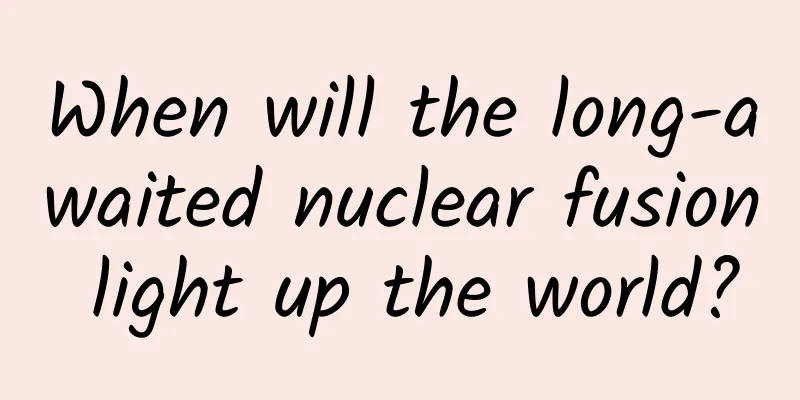When will the long-awaited nuclear fusion light up the world?

|
Nuclear fusion energy is known as the cleanest energy because it is pollution-free; it is also considered to be an unlimited energy source. This is because compared to other energy sources, there is a lot of nuclear fusion fuel on Earth and on the moon, and just grabbing a handful can generate a huge amount of electricity. For example, seawater contains 30 milligrams of heavy hydrogen, or deuterium, per liter. The energy released by the fusion of these deuterium is equivalent to burning 340 liters of gasoline. Based on the density of gasoline of about 0.725, the energy of one cubic meter of seawater is equivalent to 246.5 tons of gasoline. There are about 137 trillion cubic meters of seawater on the earth, which is equivalent to 55.58 trillion tons of gasoline as nuclear fusion fuel. In 2023, the total global energy consumption will be 21.1 billion tons of standard coal, and the thermal energy of each ton of standard coal is about 29.3GJ. The thermal energy of gasoline is even greater than that of standard coal, with a thermal energy of about 32GJ per ton of gasoline. Even if calculated at a 1:1 ratio, the nuclear fusion energy converted from seawater alone can allow humans to use it for 260,000 years according to their current lifestyle. Human beings have only a few thousand years of recorded history, and nuclear fusion energy can be used by humans for hundreds of thousands of years, so it is an unlimited energy source for humans today. Of course, this calculation is limited to the current low level of human civilization. With the upgrading of human civilization, the demand for energy will increase by thousands of times, and by then nuclear fusion will not be able to support the survival and development of human civilization. There is a scientific model that believes that when humans reach level 2 civilization, they will need to build a Dyson sphere, which is to wrap up the entire sun and utilize all the sun's energy to maintain the needs of civilization. This is another topic, so I won't go into it today. What exactly is nuclear fusion? It sounds complicated, but to put it simply, it is to compress two atomic nuclei together and fuse them into a heavier nucleus. At this stage, nuclear fusion is to compress and fuse the simplest element, hydrogen nuclei, into helium nuclei. During this fusion reaction, about 0.7% of the mass will be lost. This mass is converted into energy, and collecting this energy for power generation is the current goal of controlled nuclear fusion. Although nuclear fusion can only produce 0.7% of the energy, it is already earth-shattering. According to Einstein's mass-energy equation E=MC^2, 1kg of material can produce 9^16J of energy through nuclear fusion, which is equivalent to 25 billion kilowatts of electricity. This kind of energy is no longer limited to theory, but has been confirmed in reality. The explosion of a hydrogen bomb is the embodiment of this energy, but this instantaneous explosion is uncontrollable. Apart from war and destruction, it can basically not benefit human civilization. Therefore, nuclear fusion, which can permanently solve the energy problem of mankind, is called controlled nuclear fusion. This means that the huge energy of nuclear fusion can be released slowly and in a controlled manner so that it can be used for social and commercial applications. How to make this energy controllable has been a topic that scientists have been pursuing since the 1950s. The process of nuclear fusion takes place at the atomic level, so it is an extremely microscopic process. Atomic nuclei are extremely small substances, but it is very difficult to force them together to achieve fusion and a chain reaction, which requires great pressure. Nuclear fusion in the core of the sun is carried out under 250 to 300 billion atmospheres of pressure. This pressure cannot be achieved on Earth, so it can only be compensated by high temperature. Therefore, to achieve nuclear fusion chain reaction, the temperature must be at least 100 million degrees Celsius, which leads to several insurmountable difficulties, namely: how to reach such a high temperature, what kind of container to contain (confine) such high-temperature plasma, how to collect and utilize this energy, etc. For decades, scientists have been struggling to find ways to overcome these difficulties and have made progress bit by bit. The material on Earth that can withstand the highest temperature is hafnium alloy (Ta4HfC5), which has a melting point of 4215°C. However, this high temperature is not even a fraction of the high temperature of 100 million degrees required for nuclear fusion. Therefore, the high-temperature plasma of nuclear fusion cannot be confined by a physical shell. After research and experiments, scientists have found that the only way to confine this ultra-high temperature energy is to use invisible magnetic confinement, inertial confinement, and gravity confinement. On Earth, it is impossible to achieve the super-large gravity confinement of the core of the sun, so we can only use magnetic confinement and inertial confinement technology to solve the problem of high-temperature plasma confinement for nuclear fusion. However, after 50 or 60 years, the confinement time is still very short, especially the output power, that is, the Q value is still very low. As a result, many people are becoming more and more pessimistic about nuclear fusion and believe that the hope of success is slim. The so-called Q value is the ratio of the input energy to the output energy of the nuclear fusion process. The greater the output energy is to the input energy, the higher the Q value is. Only when the output energy is greater than the input energy can nuclear fusion technology benefit mankind. This is a bit like doing business. You can only make a profit if you have less capital and make more money. But this simple truth has been difficult to achieve in the field of nuclear fusion. So far, the largest nuclear fusion output Q value was set by the US National Ignition Facility in 2023, with a record of 1.89. Although this is a breakthrough, it was short-lived. The nuclear fusion reaction lasted only 5.2 seconds, and the output energy was only 3.88 megajoules, which is about 1 kWh. Moreover, this experiment used inertial confinement laser ignition technology, not the tokamak magnetic confinement technology commonly used in the world. The Q value achieved by magnetic confinement technology was created by the European Joint Toroidal Reactor (JET) at the Culham Fusion Center in Oxfordshire, UK in 1997. The world record for the Q value of nuclear fusion output is only 0.67, which means that if the input energy consumed is 1, only 0.67 is obtained, which is equivalent to spending 1 yuan to buy goods worth only 0.67 yuan, which is a loss-making business. In October 2023, JET used 0.21 mg of fuel and maintained a nuclear fusion reaction for 5.2 seconds after ignition, generating 69 megajoules of energy. Although it created a greater output power than 59 megajoules in 2021, it did not break the Q value record in 1997. Among the world's tokamak test stars, Japan's JT-60 is a bright spot. It set a record of maintaining confinement at 20 million degrees Celsius for 31 minutes and 45 seconds in 2004, and a record of maintaining confinement at 100 million degrees Celsius for 28.6 seconds in 2006. Before that, in 1997, it claimed to have set a record of Q value 1.25, but this record was obtained through a deuterium-tritium reaction experiment and was considered unusable for practical use. But at least it gave people hope and proved that the use of tokamaks can theoretically produce positive energy output. When will controlled nuclear fusion be truly realized for civilian use? The prospect is still bleak, and the slow progress has made many people lose patience. However, scientists around the world have not given up and are still working hard and striving for it. Among them, a group of Chinese scientists have worked particularly hard and have achieved remarkable achievements. In terms of magnetic confinement technology based on the Tokamak device, the highest temperature records are 510 million degrees Celsius set by the United States in 1995 and 522 million degrees Celsius set by Japan in 1996. However, the time of maintaining these temperatures has not been disclosed, which should be very short and probably instantaneous. The 31-minute plasma confinement record set by Japan's JT-60 was only 2,000 degrees Celsius; the 100 million degree record was only 28.6 seconds. China's "Eastern Super Ring" located in Hefei, Anhui, full name of the All Superconducting Tokamak (EAST), set a record of 120 million degrees Celsius for 101.2 seconds in May 2021, and set a record of 70 million degrees Celsius for 1056 seconds in December of the same year; on April 12, 2023, it achieved a steady-state high confinement mode plasma operation for 403 seconds, a record that has not been broken so far. As for what the Q value can reach now, no information has been disclosed yet. Moreover, the Chinese government is continuously increasing its investment in controlled nuclear fusion research. According to Paul Allen, head of the Office of Fusion Energy Sciences at the U.S. Department of Energy, the Chinese government invests $1.5 billion in nuclear fusion research each year, while the U.S. invests only about $800 million each year. Therefore, although China's nuclear fusion research started later than the United States, its pace is getting faster and faster, and the number of patents it has obtained has exceeded that of any other country. Now, in addition to the "Eastern Super Ring" in Anhui, China is making continuous breakthroughs. There is also the "Zhonghuan III" in Chengdu, which has achieved high confinement mode operation with a plasma current of 1 million amperes. There is also the BEST Tokamak project under construction, which is scheduled to be completed in 2007, and a huge investment in the International Thermonuclear Experimental Reactor (ITER) project. These projects are being advanced at full speed, and have continuously achieved breakthrough results, attracting worldwide attention. China's nuclear fusion application promotion plan aims to achieve nuclear fusion power generation in 2028 with a power of 50 million amperes. China's development roadmap in the field of nuclear fusion shows that a commercial fusion power station will be built around 2050. Therefore, many international authorities have commented that due to the Chinese government's increased investment and strong promotion, controlled nuclear fusion technology is likely to surpass some old technological powers and may be the first to light the first lamp for commercial application in the world. According to the "2024 Global Fusion Industry: Fusion Company Survey" released by the Fusion Industry Association (FIA) in July 2024, the vast majority of companies in the world are expected to achieve fusion power generation in the early 2030s. In terms of technology routes, most companies adopt the magnetic confinement technology route (23 companies), in addition to magnetic inertial confinement (5 companies), inertial confinement (9 companies), hybrid magnetic/electrostatic confinement (3 companies), magnetic inertial confinement (3 companies), meson catalytic fusion (1 company) and other non-traditional concepts/unspecified (3 companies) and other methods. In this way, the slim hope seems to be becoming more and more visible and tangible. In the foreseeable future, when the light of nuclear fusion illuminates the world, it will be the time when human technological civilization enters a new stage. Let us look forward to it. What do you think about this? Welcome to discuss. This is an original article from Space-Time Communication. Please respect the author’s copyright. Thank you for reading. |
>>: Designed in the late 1950s, the Blackbird is an absolute miracle in aviation history.
Recommend
Some details and thoughts on “Guess the Picture Song”
Quickdraw’s CNN-RNN model The quickdraw model use...
What are the functions of the WeChat data statistics applet? How to create a data statistics applet?
Have you ever had a headache facing mountains of d...
3 steps to improve the conversion of information flow, learn them!
Why is my ad not getting any exposure no matter h...
Live streaming was extremely popular in 2016, what will be the highlight in 2017?
Live streaming itself is a very "lively"...
Blocked Douyin account, forced to raise the commission of small shops [original price 8888]
Blocked Douyin account, forced to raise the commi...
Scientists have gone to great lengths to find out the "devil" element that killed generations of people
Planning and production Source: Guokr (ID: Guokr4...
Excellent product or operation: You have to understand the "emotions" and "desires" of users
As we all know, a product only has meaning if it ...
Is dandruff just caused by insufficient cleaning?
This article was reviewed by: Xiaobo Zhou, Doctor...
Fission is complete, how to do refined user retention work
At the end of the previous article "There se...
The truth about "oyster sauce can increase uric acid levels" →
Recently, several friends asked me the same quest...
Short video promotion: How to quickly attract users and achieve conversions?
In the era of content consumption, short videos h...
Mutual Finance Operation | How to build a big data risk control system from 0 to 1
Risk control is the heart of finance, and data is...
Advice from an old programmer: Don’t rely on technology for your whole life
[[225216]] I am doing it myself now, but I have b...
If you lean on people, they will run away. If you lean on trees, they will fall down. What about if you lean on the wall?
As the old saying goes, If you rely on people, th...
He is the first Chinese to win the "Nobel Prize for Meteorology" and made a bold statement: "Let foreigners catch up with us"|Time Letter
Nowadays, weather forecast has become a piece of ...









